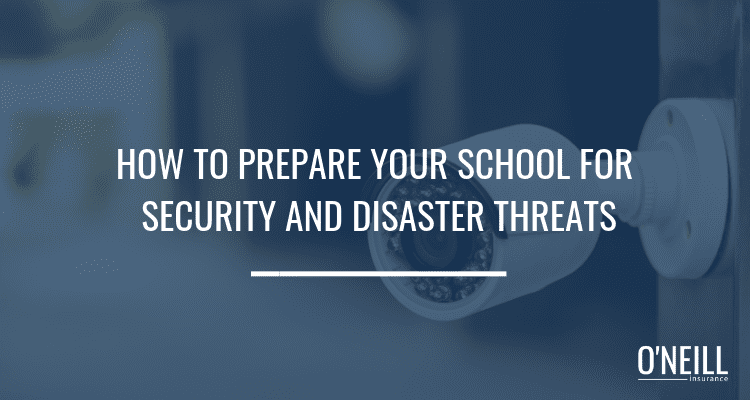
A natural disaster or security risk could happen in your school any day. It’s imperative that you have a plan to handle these potential risks, both to ensure the safety of your students and staff and to avoid a financial crisis that could shut down your school.
To prepare for the unexpected, you should review your security and disaster readiness plans to help you minimize the impact of any potentially threatening situation.
Keeping your building secure from outside criminals or unauthorized personnel is a paramount responsibility. Assess your facility’s current security features and determine where improvements should be made.
Security for Your School
Bomb threats, suspicious devices and terrorism are just a few threats to the physical property of your school. Reviewing security issues, including access control and perimeter security, is important. Taking appropriate measures to ensure security includes:
- Survey locks, fences, exterior lights and other physical security devices to ensure they are in place where needed and in proper operating condition. Establish a monthly inspection of your security perimeter and key protective features of your facility.
- Establish and follow strict visitor control procedures such as mandatory sign-ins, name badges, escorts, etc. In addition, all doors should be locked while school is in session, with a staff member monitoring who enters and exits.
- Review your procedures for issuing facility keys and access cards. All staff, including parent volunteers and part-time or seasonal staff, should be screened before being issued building access. Keep lists of who has been issued keys/cards and have a procedure for handling a situation when an employee is terminated without returning them.
- If you are considering building a new facility or renovating a current one, make sure that security and disaster resilience is a large factor in the building plans.
Student Violence
With the prevalence of school bullying and highly-publicized school violence, such as school shoots, school violence is a serious risk that could be addressed in the following ways:
- Install metal detectors at entrances to the facility, if needed.
- Hire security guards to monitor activity in the school.
- Enforce student conduct and dress code policies.
- Train staff to be observant of the warning signs of potentially violent student behavior.
- Educate students about violence.
Other Criminal Activity That Can Take Place Near Your School
Be aware of criminal activity that occurs within 1,000 feet of school property. This can include crimes such as gang activity, selling drugs and physical assaults. Crime prevention can include:
- Advising staff and volunteers to report any suspicious persons or activity in or around the building.
- Closed circuit television (CCTV) can serve as an excellent crime deterrent, and when the system is equipped with a recorder it can help solve crimes.
- Discussing security with your local police department. Police departments are often very willing to provide information and support to local schools and child care facilities.
Fire and Hazardous Materials at Your School
U.S. fire departments respond to thousands of fires annually on educational properties. In addition to conducting monthly fire drills with your local fire department, it’s also very important to:
- Pay special attention to areas where you may be storing explosive, flammable or toxic chemicals. These areas should be properly secured and inventories, with limited hands-on contact of these materials when possible.
- Evaluate critical locations in your facility for proper security, including the electric, telephone and gas units, building entrances, transformers, outside storage units and computer rooms.
- If your facility has a security and/or fire alarm system, be sure it’s operating properly and that key personnel know how to use it.
- Make sure that fire suppression systems are regularly inspected and maintained. Also be sure that a sufficient number of trusted personnel know how to activate, operate and shut them down.
- Have your local fire department conduct a pre-planned visit to your building. While there, they can identify potential hazards and plan fire suppression priorities.
Disaster Planning and Response
Though not all security threats can be avoided, some situations can be prevented with appropriate preparation. Due diligence is your responsibility; if you do not have sufficient security measures in place, you could be held liable for any vandalism, theft or student injury that occurs:
- Be sure to discuss applicable natural disaster coverage with your insurance agent
- Keep copies of insurance policies and other critical documents in a safe and accessible location (e.g. a fireproof safe)
- Evaluate which disasters are most likely to occur in your area. Be sure you are prepared for all of the risks you identify.
- If your school is part of a larger campus or district, you should have plans specific to your facility and then further procedures for collaborating with the larger entity.
- Make sure your emergency response procedures are comprehensive and up to date. This may include evacuation, building lockdown, communication with authorities and/or parents, or other responses depending on the situation.
- Conduct periodic drills that include your entire population of staff and students, so that everyone is familiar with emergency procedures. Include security and disaster response education in the curriculum. Parents should also be educated on the school’s security and disaster response procedures.
- Determine which staff members are in charge in an emergency situation and establish a chain of command and reporting for easy communication within the building. You also need an established procedure for which district administrators and local authorities need to be contacted in each situation.
- Have telephone call lists available for all key personnel so staff members can be contacted during non-working hours from any location. You also should have a parent or guardian contact information for each student. Review procedures for notifying staff and parents that your facility is closed. Remind all parties that they should never attempt to enter areas that are closed by police or other emergency responders.
- Consider establishing an alternate method for your phone service if it he switchboard becomes unusable.
- Check available emergency supplies such as flashlights, batteries, emergency generators/fuel, patching materials such as plastic sheeting, wood 2x4s, duct tape, spare fire extinguishers, first aid kits, etc.
- You also need to establish a recovery plan for coping after a disaster situation. This will include physical recovery of building functions and infrastructure, a plan for resuming school as soon as possible, and also emotional recovery for staff and/or students in some situations.
The security of your school is critical to the safety of your staff, your students and their families. This article outlines the basic ways you can ensure your school properly equipped with the right security measures to safeguard your students, but does not encompass all security measures.
My name is Tom Van Auker and I’m a certified School Risk Advisor here at O’Neill Insurance. I’d love to connect via phone or email to discuss the your school’s risk management and insurance program, and ensure that you have the right coverage in place. Call me at 330.331.7952 or email me at tvanauker@oneillinsurance.com to get started.
This article was adopted from Zywave’s “Education Risk Insights: Prepare Your School for Security and Disaster Threats”

